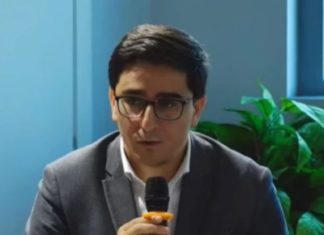LOS ANGELES / YEREVAN – In mid-October, when the war in Artsakh was intensifying, Dr. Armen Aboulian, a general and colorectal surgery specialist in Los Angeles, was one of the doctors who rushed to Armenia to save lives. This wasn’t his first visit to homeland though. For five years in a row, Dr. Aboulian was teaching innovative practices of laparoscopic colon cancer surgery to his colleagues at the Astghik Medical Center in Yerevan.
This time, when he arrived to Yerevan, the Armenian Ministry of Health gave him the option of volunteering in one of two hospitals in the capital city: Erebuni Medical Center or Astghik, where many soldiers from Artsakh were already admitted. Aboulian chose Astghik Medical Center, where he stayed for two and a half days. However, after a few days, he realized that most of the patients who were receiving treatments there had already undergone surgeries in hospitals in Stepanakert or other regions. Dr. Aboulian soon realized that he could contribute more if he was closer to the frontline.
Moving to Goris Medical Center in Goris, Armenia, Aboulian joined a group of doctors and other medical professionals from diaspora and local medical facilities. The days were full of events, sometimes filled with the horrors of war and sometimes with the pure joy of a saved life.

“Unfortunately, we would see all types of injuries. The majority of them were from explosions; a lot were penetrated shrapnel injuries. In fact, when we would see a gunshot wound, we would be relieved in a sense in that at least some of the soldiers were in a gunfight. They would have been able to see where the attacks were coming from. Unfortunately, with the explosions, drones and aircraft bombs launched against Artsakh, most soldiers didn’t have a chance to defend themselves,” explains Aboulian.
“At one point, we even encountered a few soldiers with issues that we had a very hard time to figure out. The soldiers had evidence of a severe lung injury, almost a burn-type injury to the lungs, but there was no sign of a burn on the outside of the body. I’m assuming there was a chemical or barotrarumatic injury that had been caused to the lungs that manifested itself similar to a burn injury. That was the first time that I encountered something like this in my career.” In retrospect, having had a chance to have researched the topic, Dr. Aboulian thinks this was a thermobaric weapon which uses oxygen from surrounding air to generate a high temperature explosion.
Goris Medical Center was admitting patients directly from the frontline and others who were being transferred from the different regional hospitals. They were using Goris Medical Center as a stopping point in order to be transferred again to Yerevan. Doctors in the hospital could check the intensity of military actions with the frequency of arriving ambulance vehicles. “There would be times that three or four hours would go by, and we wouldn’t have a single patient. And there would be times when three ambulances would come with three or four patients in each ambulance,” remembers Aboulian.










